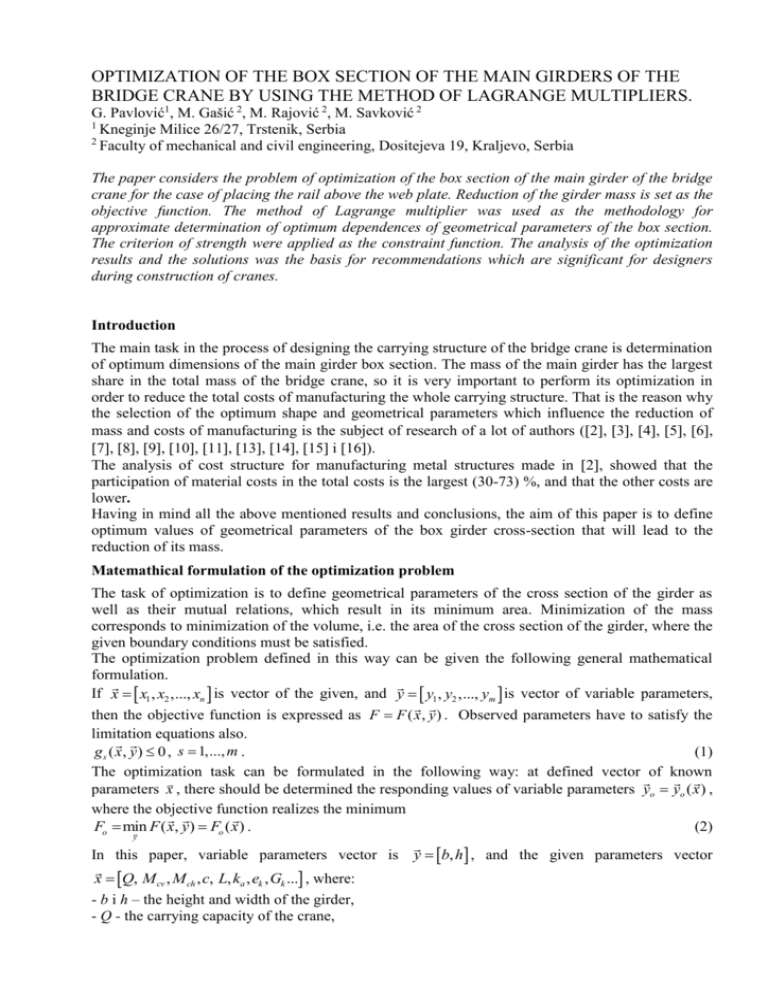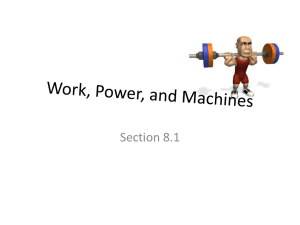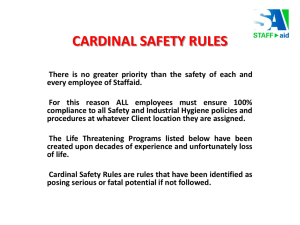MIT-2013-GPavlovic
advertisement

OPTIMIZATION OF THE BOX SECTION OF THE MAIN GIRDERS OF THE BRIDGE CRANE BY USING THE METHOD OF LAGRANGE MULTIPLIERS. G. Pavlović1, M. Gašić 2, M. Rajović 2, M. Savković 2 1 Kneginje Milice 26/27, Trstenik, Serbia 2 Faculty of mechanical and civil engineering, Dositejeva 19, Kraljevo, Serbia The paper considers the problem of optimization of the box section of the main girder of the bridge crane for the case of placing the rail above the web plate. Reduction of the girder mass is set as the objective function. The method of Lagrange multiplier was used as the methodology for approximate determination of optimum dependences of geometrical parameters of the box section. The criterion of strength were applied as the constraint function. The analysis of the optimization results and the solutions was the basis for recommendations which are significant for designers during construction of cranes. Introduction The main task in the process of designing the carrying structure of the bridge crane is determination of optimum dimensions of the main girder box section. The mass of the main girder has the largest share in the total mass of the bridge crane, so it is very important to perform its optimization in order to reduce the total costs of manufacturing the whole carrying structure. That is the reason why the selection of the optimum shape and geometrical parameters which influence the reduction of mass and costs of manufacturing is the subject of research of a lot of authors (2, 3, 4, 5, 6, 7, 8, 9, 10, 11, 13, 14, 15 i 16). The analysis of cost structure for manufacturing metal structures made in 2, showed that the participation of material costs in the total costs is the largest (30-73) %, and that the other costs are lower. Having in mind all the above mentioned results and conclusions, the aim of this paper is to define optimum values of geometrical parameters of the box girder cross-section that will lead to the reduction of its mass. Matemathical formulation of the optimization problem The task of optimization is to define geometrical parameters of the cross section of the girder as well as their mutual relations, which result in its minimum area. Minimization of the mass corresponds to minimization of the volume, i.e. the area of the cross section of the girder, where the given boundary conditions must be satisfied. The optimization problem defined in this way can be given the following general mathematical formulation. If x x1 , x2 ,..., xn is vector of the given, and y y1 , y2 ,..., ym is vector of variable parameters, then the objective function is expressed as F F ( x , y ) . Observed parameters have to satisfy the limitation equations also. g s ( x , y ) 0 , s 1,..., m . (1) The optimization task can be formulated in the following way: at defined vector of known parameters x , there should be determined the responding values of variable parameters yo yo ( x ) , where the objective function realizes the minimum (2) Fo min F ( x, y) Fo ( x ) . y In this paper, variable parameters vector is y b, h , and the given parameters vector x Q, M cv , M ch , c, L, ka , ek , Gk ... , where: - b i h – the height and width of the girder, - Q - the carrying capacity of the crane, - Mcv i Mch - the bending moments in the vertical and horizontal planes, - c – the coefficient of influence of the dead weight of the girder on the bending moment - L- the span of the crane, - ka - the dynamic coefficient of crane load in the horizontal plane, 12, - ek - the distance between the cab and the crane runway, - Gk – the mass of the crane cab. The paper observes the following limitation: g max k 0 , where: max - the maximum equivalent stress, k - the permissible stress. The Lagrange function is defined in the following way: A g , where the following must be fulfilled: A g 0; 0, b b b A g 0; 0, h h h 0; g 0 . (3) (4) (5) (6) (7) Objective function The objective function is represented by the area of the cross section of the box girder (Fig. 1). The paper treats two optimization parameters (h, b). The wall thicknesses t1 and t2 (Fig. 1) are not treated as optimization parameters for the purpose of simplification of the procedure. Their values were adopted in accordance with the recommendations of crane manufacturers 1. Fig.1 The box section of the main girder of the bridge crane The area of the cross section, i.e. the objective function, is: A(h, b) f (h, b) 2 (e b h h 2 ) / s , (8) where: e t1 / t2 - the ratio between thicknesses of plates at the flange and at the web, s h / t2 - the ratio between the height and thickness of the plate at the web, k h / b - the ratio between the height and width of the girder. To know the optimal value of the ratio between the height and width of the girder k is of particular significance for the designer, especially in the initial design phase. The expressions for the moments of inertia around the x and y axes are: 1 h4 1 ( s e) 2 3 (9) Ix e b h , 6 s 2 s3 1 h 3 1 h 2 ( f b s h) 2 , (10) Iy e b 6 s 2 s s2 where: f b1 / b 1 - the ratio between the distance of web plates and the width of flange plates of the box girder. Since the expressions for the moments of inertia (Ix, Iy) and the section moduli (Wx, Wy) are complex, it is common to take approximate values of expressions by neglecting the members of the lower order (8, 9, 14, 15 i 16): I x x 2 h 2 A , Wx x h A , (11) I y y 2 b2 A , W y y b A , where: x , y - the dimensionless coefficient of the moment of inertia for the x and y – axes, (12) x , y - the dimensionless coefficient of the resistance moment of inertia for the x and y – axes. The coefficients x and x are obtained from the conditions of equality of the equation (9) and the expression (11): 2s 1 k s 2 3 e ( s e) 2 x2 . , x (13) s 2e 2 s 3 (e k ) Using the fact that s e and s k the coefficients with the form x and x can be simplified: x 1 k 3 e k 3 e , `x . (14) 2 3 (e k ) 6 (e k ) By repeating the procedure for the moment of inertia and the section moduli for the y – axis, the following values of coefficients are obtained: `x 1 e s 2 3 k ( f s k )2 , y 2 y2 , 2 s 3 (e k ) i.e. in a simpler form: y 1 2 `y 3 k f 2 e 3 k f 2 e , `y . 3 (e k ) 6 (e k ) (15) (16) Constraint function The maximum equivalent stress which occurs in the main girder of the bridge crane is at point 1 (Fig. 1). The constraint function according to this criterion is: M M (17) max zV 1 zH 1 VI HI k , Wx Wy k f y / 1 , where: f y - the minimum yield stress of the plate material, (18) 1 - the factored load coefficient for load case 1. The constraint function according to this criterion is: M c A M ch ka c A g g (h, b) cv k 0 . x h A y b A By eliminating the parameter from equations (5) and (6), we get: (19) A g A g . b h h b The corresponding partial derivatives are: M g 1 A M ch 1 A M ch 1 1 ka c 1 cv 2 2 2 , b y b 2 x h A b y b A b y A b (20) (21) M cv 1 A M cv 1 1 M ch 1 A g c 1 2 2 2 2 . h x h A h x A h x h y b A h By replacing the expression (21) in (20), after rearrangement, the following relation is obtained: M cv c A A M ch ka c A A (22) , x h2 A b y b2 A h A A 2 e h / s, 2 (e b 2 h) / s. (23) b h Using (19), we get: M cv c A M ch ka c A (24) k . x h A y b A Using relations (5) and (23), we get the parameter value : A2 . (25) M cv M ch M ch ka c A A x h y b 2 A y b b From the equations system (22) and (24), it is necessary to find the optimal dimensions h and b by the given criterion, i.e. their relation k . As the net weight moment is considerably smaller than the moment caused by active load, it can be written: M cv c A M cv , (26) M ch ka c A M ch where now it is necessary to analyze this relation. Fig.2 Approximation of the ratio between bending moments in the vertical and horizontal planes As ek 2,5 m , [12] is notably smaller than the crane span L , it is shown in diagram (Fig. 2) that the cabin influence is not of great significance for this analysis, where the driving class 2 is observed. Now it can be written: M cv M `cv 1 R ( L e1 )2 1 Q mk Q mo K Q , M ch M `ch ka Rh ( L e1 )2 ka Q mk Q mo K Q where: K - the coefficient of influence of the classification class on the mass of the trolley, - the dynamic coefficient of the influence of load oscillation in the vertical plane, - the coefficient of influence of the load mass on the mass of the trolley, mo - the assumed mass of the trolley in the first approximation. As we can see (Fig. 3), this relation depends both on capacity and driving class. (27) R/Rh 1.15 1.10 1.05 1.00 5 10 15 20 25 30 35 40 45 50 Q(t) Fig.3 The relationship between the load in the vertical and horizontal planes If the relation (27) is shown by the functions: M cv 1 f1 (Q) 1 Q mo K Q 1 c1 , M ch ka f 2 (Q) ka Q mo K Q ka f (Q) Q mo K Q R 1 , Rh f 2 (Q) Q mo K Q and if it develops (29) into Taylor series, the expression (28) becomes, M cv 1 f1 (Q) 1 f1 (Qo ) (Q Qo ) f1 `(Qo ) . M ch ka f 2 (Q ) ka f 2 (Qo ) (Q Qo ) f 2 `(Qo ) Now the expression (22) can be written in the following way: M cv c A A M cv A x h 2 A . M ch ka c A b M ch b y b 2 h c1 Corresponding partial extracts of the objective function (8), by the variables b and h read: A A 2 e t2 , 2 t2 . b h Replacing relations (32) into (31), we finally get: e y M cv e y c1 kop . x M ch x ka (28) (29) (30) (31) (32) (33) When the relation k op is known, from the limitation equation (19) the girder height is determined. Objective function can be written in the following way. 2 e A ( 1) h 2 . (34) s k From relations (19) and (34) we get: c ka c M cv M ch kop kop x y y s x 0. 3 2 hop hop (35) k 2 k (e / kop 1) By solving the equation (35), we come to the wanted solution of optimal height. Optimal width is obtained by the expression:: bop hop / kop . (36) Limitation function can also be written in the following form: M cv M ch kop Aop A(h) x k h y c x ka c y . (37) kop Numerical representation of the results obtained Using the expression (33) the optimum value of the parameter k according to the criterion of permissible stress is obtained as a function of the Q and ka (Tab.1). Using the expressions (8), (25), (35) and (36) the optimum values of the parameters h, b, A and according to the criterion of permissible stress are shown in Tab.2. Table 1 Q (t) ka 0,085 0,1 0,115 5 6,3 8 10 12,5 16 4,67 4,30 4,01 4,68 4,31 4,02 4,68 4,32 4,03 4,69 4,32 4,03 4,69 4,33 4,03 4,70 4,33 4,04 Table 2 h (cm) b (cm) A (cm2) S235 117,9 27,2 173,1 5,85 S275 108,8 25,1 158,8 4,57 S355 95 21,9 138,9 3,08 Fig.4 Optimum values of the girder height and the objective function according to the strength The expression (37) represents the objective function obtained from the constraint function according to the criterion of permissible stress and together with the objective function (34) it can be graphically represented. At the intersection of these curves, on the abscissa, there is an optimum height h for the constraint function according to the criterion of permissible stress. Figure 4 shows how the position of the intersection point changes depending on the selection of material (solid line for S235, dash line for S275 and dot line for S355). One of the main parameters figuring in the objective function (8) is slenderness s , defined as (12): 160 23,5 / f y s 265 23,5 / f y . (38) For initial analysis, the medium values can be adopted, so that for S235 we take the value s 210 . Other parameter values, at this stage, are: e 1,33, f 0,85, ka 0,1, ek 2,3 m, Gk 15 kN . To perform the analysis, it is necessary to perceive the recommendations listed in the standard, but also those given by the crane producers [1]. Recommendation of Serbian crane producers is that the minimum width value b1 is b1 30 cm , from which we get: k f h / 30 , (39) while the sheet metal stability condition of the upper belt, with appropriate transformations, is defined as: s f k 23,5 / f y . (40) 65 e If we equate the expressions (7) and (37), we get the parameter dependency k , by hardness criterion: k F s, e, h, M cv , M ch , x , y . (41) Fig.5 Determination of the optimum value of the parameter k for the crane span L=18m and the carrying capacity Q=16t Fig.6 Determination of the optimum value of the parameter k for the crane span L=15m and the carrying capacity Q=12,5t In diagrams (Fig.5 and Fig.6) are shown the obtained optimal geometric parameters for characteristic capacities and spans of two pillar bridge cranes. Thus performed procedure enables fast and effective determining of optimal value of parameter k by critical function. Width value b1 does not influence the optimization procedure, but it influences the obtained values of optimization parameter k (Fig.6). Conclusion The paper defined optimum dimensions of the box section of the main girder of the bridge crane in an analytical form, by using the method of Lagrange multipliers according to permissible stress. The objective function is the minimum mass, i.e. the minimum area of the cross section. The results obtained may be of great use to the engineer-designer, particularly in the first phase of the design procedure when the basic dimensions of the main girder of the bridge crane, as its most responsible part, are defined. Justification of applying the method of Lagrange multipliers was also shown because the optimization results were obtained in an analytical form, which allows drawing conclusions on the influence of certain parameters and directions of further research concerning the reduction of mass. Literature 1 Catalogues, And as-built projects of Serbian crane manufacturers, IMK 14 Oct., MIN, ILR, 1996 2 Farkas J., Optimum design of metal structures, Akademiai KIADO, Budapest, 1984 3 Farkas J., Economy of Higher-Strength Steels in Overhead Travelling Cranes with Double-Box Girders, J. Construct, Steel Research 6: 285-301, 1986 4 Farkas J., Jármai K., Analysis and optimum design of metal structures, Balkema, Rotterdam, 1997 5 Farkas J., Simoes L.M.C., Jarmai K., Minimum cost design of a welded stiffened square plate loaded by biaxial compression, Structural and Multidisciplinary Optimization, 29:298–303, 2005 6 Farkas J., Structural optimization as a harmony of design, fabrication and economy, Structural and Multidisciplinary Optimization, 30:66–75, 2005 7 Farkas J., Jármai K., Snyman J.A., Global minimum cost design of a welded square stiffened plate supported at four corners, Structural and Multidisciplinary Optimization, 40:477–489, 2010 8 Gašić M., Savković M., Bulatović R., Petrović R., Optimization of a pentagonal cross section of the truck crane boom using Lagrange’s multipliers and differential evolution algorithm, Meccanica. Online First 13 August 2010. doi:10.1007/s1 1012-010-9343-7 9 Gašić M., Savković M., Bulatović R., Optimization of trapezoidal cross section of the truck crane boom by Lagrange’s multipliers and by differential evolution algorithm (DE), Strojniški vestnik – Journal of Mechanical Engineering 57, 4:304-312, 2011 10 Jarmai K., Decision Support System on IBM PC for Design of Economic Steel Structures Applied to Crane Girders, Thin-Walled Structures, 10: 143-159, 1990 11 Jarmai K., Farkas J., Optimum cost design of welded box beams with longitudinal stiffeners using advanced backtrack method, Structural and Multidisciplinary Optimization, 21:52–59, 2001 12 JUS M.D1.050 (1968) Standards for cranes. Yugoslav Institute for Standardization, Beograd. 13 Pavlović G., Savković M., Zdravković N., Optimization of box-girder cross-section of the main bridge cranes according to the criteria of lateral stability (Optimizacija kutijastog poprečnog preseka glavnog nosača mosne dizalice prema kriterijumu bočne stabilnosti), IMK – 14 Research and Development (IMK – 14 Istraživanje i razvoj), (41), 4/2011 14 Savković M., Optimization of Complex Cross Sections of Structures of Autocrane Booms (Optimizacija složenih poprečnih preseka konstrukcija strele autodizalice). (IMK -14- Research and Development) IMK -14- Istraživanje i razvoj 20-21(1) pp. 41:45, 2005 15 Savković M., Gašić M., Ćatić D., Nikolić R., Pavlović G., Optimization of the box section of the main girdre of the bridge crane with the rail placed above the web plate, Structural and Multidisciplinary Optimization, DOI: 10.1007/s00158-012-0813-5, 2012 16 Šelmić R., Mijailović R., Optimization of trapezium cross-section in structures, Facta iniversitatis mechanical engineering, Niš, Vol. 1, N5/1998, pp. 555–564




